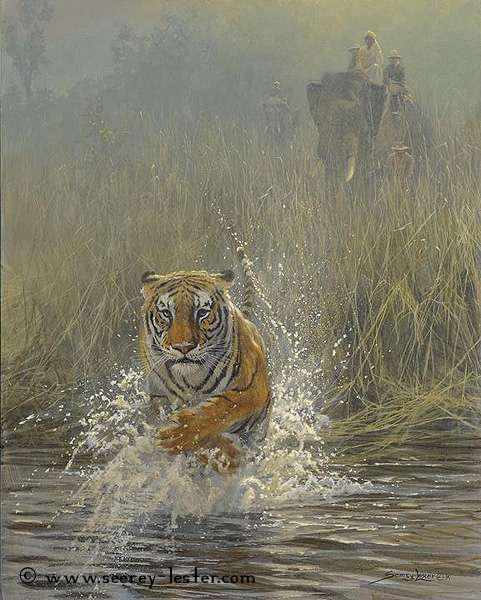
"Running
Scared"
Acrylic, 20x16"
SOLD
“Tigers are very protective of
their territory, particularly if they are with young or on a
kill – a fact which makes this story, recounted here in
words and paint by artist John Seerey-Lester, all the more remarkable.”
Jim Corbett’s name is synomous with
tigers, having tracked and killed some 12 man-eaters, between
1907 and 1938. The tigers and leopards he shot were responsible
for killing over 1500 men, women and children. He preferred to
hunt alone and on foot. His incredible stalking prowess, sometimes
getting to within just a few feet of his quarry to ensure the
accurate identity of the cat before shooting, earned him the
reputation as one of India’s finest hunters. Such was the
respect that the name Sadhu (Saint) was bestowed upon him by
the village people of Kumaon in northern India who credited him
with saving thousands of lives.
I have personally encountered tigers
in the wild and seen their anger first hand. I was on the back
of an elephant one time, and had unknowingly crossed a tiger’s
unseen boundary. First, there was a low growl, which my mahout
ignored; this was followed by a louder growl and a snarl, then
came a terrifying roar and bluff charge. The elephant reared
its head and screamed. This caused the tiger to leap through
the air and land, thankfully, some 25 feet, away. I was 12 feet
off the ground and can’t imagine being in the same situation
on foot and unarmed. But this is exactly what happened to Jim
Corbett.
Corbett had been fishing one evening
with his sister on the Boar River near his home in northern India.
Having had a successful catch, he was sitting on a rock enjoying
the evening and a quiet smoke. His solitude was broken when a
friend and neighbor, Geoff Hopkins, showed up on the back of
an elephant. Apparently he was out hunting for small game for
the table armed with a .240 rook-rifle. Some friends had arrived
at his home un-expectantly ,and he hadn’t got enough food.
Having done all the fishing necessary, Corbett and his sister
agreed to join Hopkins and mounted one of the elephants to join
him in his quest. The mahout guided them across the river and
to a more likely area for peafowl and kakar (barking deer). They
traveled through a plum jungle and then into long grass. Corbett,
the ever-attentive hunter and naturalist, noticed something out
of place lying under a tree. He urged the mahout to guide the
elephant towards the object. Looking down into the grass, he
saw it was a dead Cheetal (spotted deer). Stopping the elephant,
they checked the surrounding area to be sure there was no danger,
then Corbett slipped to the ground to investigate. The other
three remained on the elephant scanning the landscape for tiger
or leopard. On close inspection he discovered that it was an
old hind and had probably been dead for more than a day. Corbett
could find no noticeable injuries so he concluded it had probably
been killed by a snake. As he started back towards the elephant
he noticed some fresh blood on a leaf. Nearby he noticed a distinctive
fresh blood trail leading past and away from the dead hind. He
decided to follow it though the grass, signaling for the elephant
to follow. Hopkins urged him to be careful, but Corbett was puzzled
by the fresh blood trail and had to see where it would lead.
He had now followed it for more than seventy yards as it led
him towards some tall grass and low bushes. Very cautiously he
leaned forward and with outstretched arms parted the grass and
bushes. There facing him, eating a Cheetal stag, was a tiger,
which looked up at him with an expression of “Well, I’ll
be dammed!”, which was exactly what Corbett was now saying
to himself. He froze; indeed, he said later “I think my
heart had stopped beating”; the tiger looked straight at
him and was so close that an outstretched paw could have swatted
Corbett’s head. Surprisingly, the tiger simply turned and
sprang though the grass and crossed a small creek. It was then
that the mahout shouted in horror “Khabardar, Sahib. Sher
Hai” (telling him to be careful, there is a tiger). Those
on the elephant had only seen the tiger, when it turned around
and sprang through the grass and crossed the creek.
Corbett determined that this was a classic
example of a tiger’s good-tempered nature not commonly known
by many people.
After his death in 1955, the Corbett
National Park in Kumaon in northern India, was named in his honor,
and in 1968 a subspecies of tigers was given the common name:
Corbett’s Tiger. Geoff Hopkins later became Conservator
of Forests, Uttar Pradesh.
See this and over 100 true stories
and paintings in the book Legends of the Hunt by John
Seerey-Lester to be published soon.
|